
If the construction of the private domain content system is not paid attention to, and the private domain content strategy is only “promotional activities” and “hard and wide” products, all high-net-worth users will eventually be lost.
Recently, when I consulted a clothing brand CRM leader on private domain and membership strategy, I emphasized this in particular.
For example, this clothing brand promoted the combination of the private domain of the store and the private domain of the headquarters during the mask period, and the person in charge of the private domain used low-price activities such as “flash sale” and “in-house purchase” to attract private domain users in order to improve performance.
Although the performance of the private domain has improved, the lack of global thinking has brought many problems. As a result, after two years of “promotional private domain”, the group finally cut off the entire private domain section.
When I diagnosed her project, I found two of the biggest problems:
First, customer orders dropped by 30%, and high-net-worth users plummeted;
Second, the conflict between public and private pallets has caused many contradictions.
When private domain operations become “online clearance channels”, brands overdraw not only user trust, but also the lifeline of future growth.
After brand and member reshaping, we have come out of the trauma of low prices in the private domain, and the LTV of high-net-worth users has returned. At this time, the brand realized that it was not that the private domain was not good, but that the method was wrong, and relying on promotion to pursue rapid performance growth was very harmful to high-net-worth members
This incident gave me the greatest inspiration, links, content, and data are the three core elements of doing a good job in the private domain, even if the link is good, the tools are complete, and the data is perfect, but the content strategy is wrong step by step, and the private domain content is the most important but the most difficult part to break through at present.
Today, when the traffic dividend fades, the private domain competition has entered the stage of “content endurance competition”, not only a single promotional content can pull the trigger for users to buy, and do not pay attention to the construction of a three-dimensional private domain content system.

What does a product manager need to do?
In the process of a product from scratch, it is not easy to do a good job in the role of product manager, in addition to the well-known writing requirements, writing requirements, writing requirements, there are many things to do. The product manager is not what you think, but will only ask you for trouble, make a request:
View details >
In the end, the private domain is the content power of the private domain, and this is the matter.
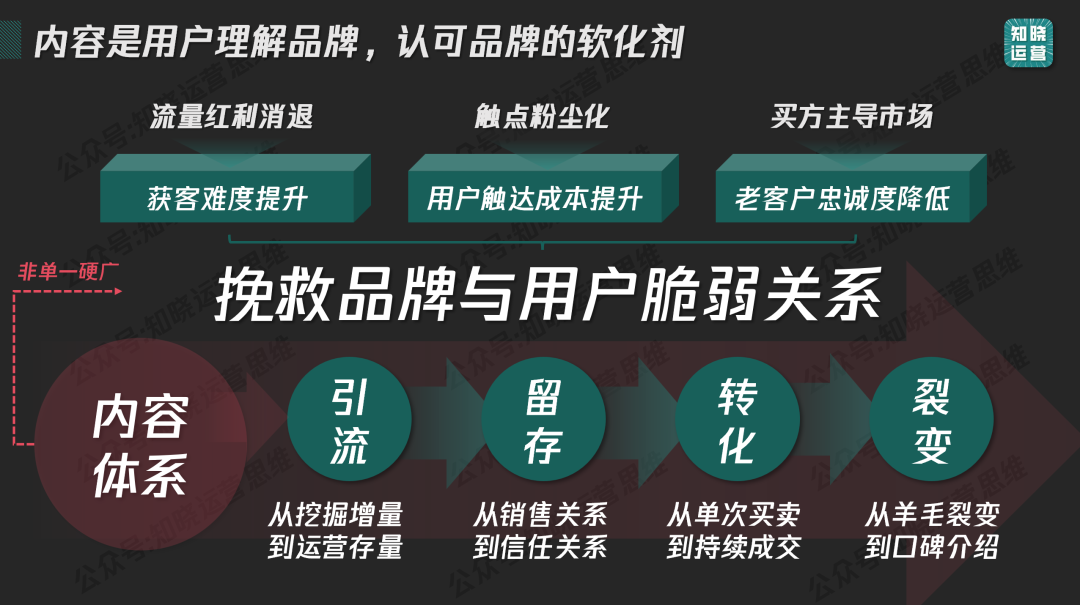
The core logic of private domain operation lies in using 1-to-1 refined user management and personalized content supply as the dual engines to continuously deepen user loyalty and extend user life cycle value.
In this process, “content output” is the core driving force that runs through the whole link. It is not only the focus of attracting users’ attention, but also the underlying driving force to leverage user conversion and activate repurchase behavior.
Content quality directly anchors the final results of private domain operations:
– High-quality content can accurately reach users’ emotional resonance points, activate high-frequency interactive participation, and build a moat of trust between brands and users.
– Private domain content marketing is like a value transmission link, penetrating the user’s mind in a warmer way, completing the transition from “functional cognition” to “emotional identity”, and ultimately leaving brand memory in the user’s mind.
Next, I will systematically and comprehensively sort out the three chapters of “Opening the Private Domain Content Dilemma”, “The Awakening of the Private Domain Content System”, and “The Construction of the Private Domain Content System” in 9,000 words. The old rule, avoid getting lost three times in advance.
01 Three major pitfalls of private domain content
Trap 1: Hard bombing, shredder trusted by users
The case at the beginning of the article is deeply trapped in the trap of “advertising-style” private domain content, resulting in the direct abandonment of the private domain.
The essence of the WeChat ecosystem is a “social trust field”, not an “advertising exchange”. The core of the private domain is to establish long-term user relationships, and the hard and bombing operation model goes against this essence.
According to the actual data of a previous retail store private domain project, the user retention cycle of pure promotional content is only 7.2 days, while the retention period of lifestyle and membership content is as long as 45 days. When brands bombard users with industrialized hard broadcasting, they are actually destroying the most precious asset in the private domain, that is, emotional connection.
Although this kind of “lazy private domain” is like drinking poison to quench thirst, although it may bring GMV growth in the short term, but in the long run, it damages the brand tone, leads to the loss of users, and even has to cut off the private domain business in the end, just like the clothing brand in the case.
Trap 2: Idling membership, the illusion of content retention
Previously, I did consulting and escorting services for private domain members for a fried chicken chain catering brand, and when doing member data analysis, I found that the churn rate of the first order was as high as 95%, and the number of stored value members consumed cards was only 75%.

After investigation, it was found that there is only a set of hierarchical membership systems, and there is no way to reach private domain members, and there is a lack of strategies and actions for private domain content around member activation.
After entering the private domain and joining the private domain, there is no content SOP within 30 days, and there is no content operation at the three major touchpoints of community, private chat, and circle of friends.
“You give me points, but are you sure you understand me?”
What private domain membership operation requires is not cold digital rights, but a “feeling of being understood”, and the content operation of the three major touchpoints is the lowest configuration of operation methods.
Coupled with the WeChat ecosystem, official accounts and video accounts can continue to provide ammunition for content reach, establish emotional connections through content, and let users feel the value and care of the brand, rather than just stimulating user consumption with discounts.
Trap 3: IP dependence, lack of content production mechanism
is also a customer of the escort service, a proprietress of a fish hot pot brand “Sister Liu”, combined with her personal IP, the private domain activity and repurchase are very high.
But her core pain points are, for example, when she took a week off due to illness, she couldn’t keep up with the content in her circle of friends or community, her activity couldn’t keep up, and the number of orders from old customers was cut in half.
This exposes the shortcoming of private domain personified IP: non-reproducibility.
From the perspective of content production organization, when an enterprise is chained and scaled, private domain content cannot rely on “super individuals”, but should build a “content production center” and no longer rely on the IP itself.
Instead, it builds a set of content production processes through team content collaboration + content production tool empowerment, such as learning and analyzing the style and tone of the IP itself through AI, and producing community and friend content by imitating tone and style;
Even through voice cloning, voice content with the same voice as the IP itself is produced, and interacted with in the community or private chat.
For example, I saw an interesting marketing event a long time ago, Haier’s “Coin Extreme Challenge” activity, through standardized content templates, so that shopping guides across the country can copy the content model of “challenge video + scenario-based explanation”, and achieve a double explosion of voice volume and conversion through private domain and short video interaction.
Brands need to transform the influence of personal IP into replicable organizational capabilities, and ensure the stability and sustainability of private domain content by establishing a standardized content production system to avoid operational fluctuations caused by personal factors.
Extending from the above three traps, it is also the core problem of the current situation of private domain content operation, lack of cognitive awareness, lack of operation methods, and lack of production mechanism, and then we will break them one by one.
02 The awakening of private domain content reconstructs the “oxygen” theory of private domain
1. What is private domain content?
To do a good job in the private domain content system, we must first figure out what private domain content is, and then what good content looks like.
In a narrow sense, private domain content may be understood as a private chat with a user, a circle of friends, or a shopping guide message pushed in the community.
This is just one of the forms of private domain content, I think private domain content, it is not limited to shopping guide copywriting, product posters and shopping guide links, but the brand’s own user pool as the carrier, stimulating users to associate with the brand, that is, “private domain content”:
For example, interactive content (such as Q&A, voting), scenario-based graphics and text (such as pictures and copywriting of usage scenarios), real-time live broadcasts (such as course lectures or remote shopping guides), gamified tasks (such as check-ins or challenges), immersive experiences (such as mini program interaction), and UGC content (such as stimulating user production content)……
And all this content should run through the private domain operation position, not just a single private chat scene, and need to have a unified plan.
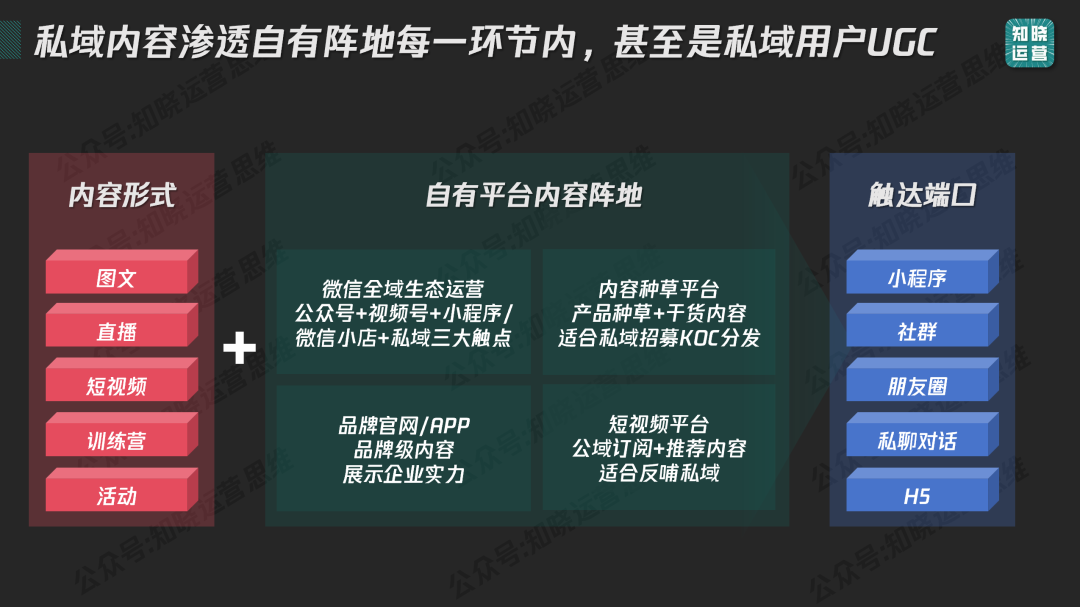
Therefore, the content form is rich because of different operational goals, although the ultimate goal is to hope that users will buy our products, but it is not to throw links to users to place orders, but to help brands in fragmented scenarios, constantly deepen their impressions, continue to add points, and then reach the psychological threshold of purchase.
2. Why is private domain content as important as oxygen?
Raise the perspective to the global dimension, as shown in the figure below, the importance of content is everywhere.
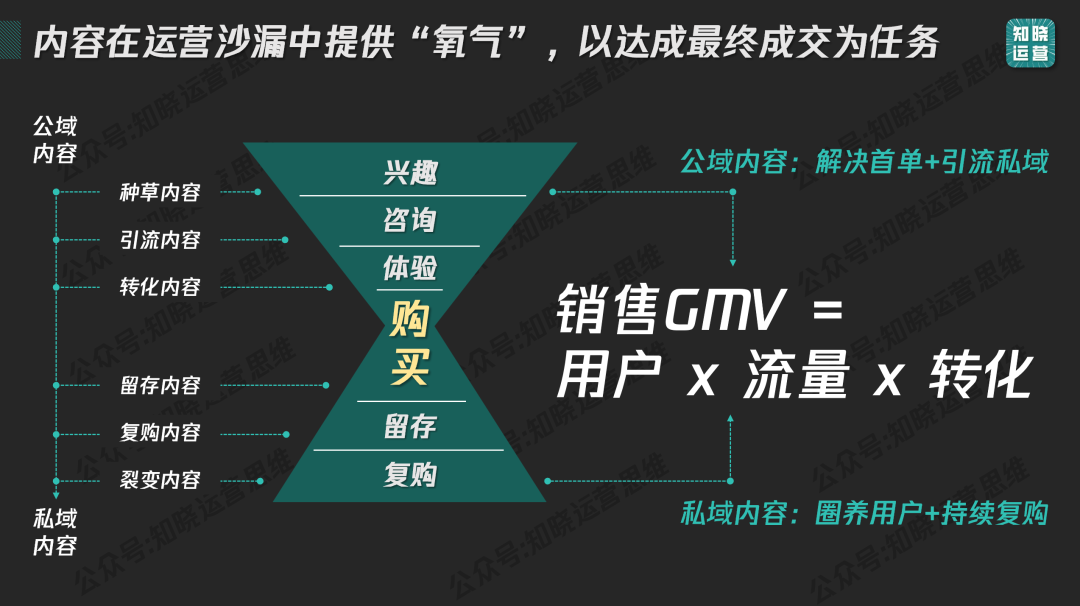
The process of public-private domain linkage operation belongs to the “hourglass type”, the public domain presents an inverted triangle, the private domain presents a positive triangle, and the purchase is the end of the public domain and the starting point of the private domain.
It is particularly suitable for private domains such as public domain order fans, store first purchase fans, and low-to-high lead fans.
For the private domain, the core goal of public domain content is to acquire customers, while the “content” of the private domain is oxygen, constantly maintaining user activity after customer acquisition, so as to extend the continuous purchase of users during the user life cycle.
3. How does private domain content run through the AARRR model?
In the traditional cognition, the private domain is the “traffic pool”, but from the perspective of content operation, the private domain is the “user’s respiratory system”, and the content is the oxygen that maintains user activity.
Continuing with an old classic case: Haier washing machine “coin challenge” event marketing, go back 8 years to see how they integrated public domain creativity and store private domain under the AARRR model.
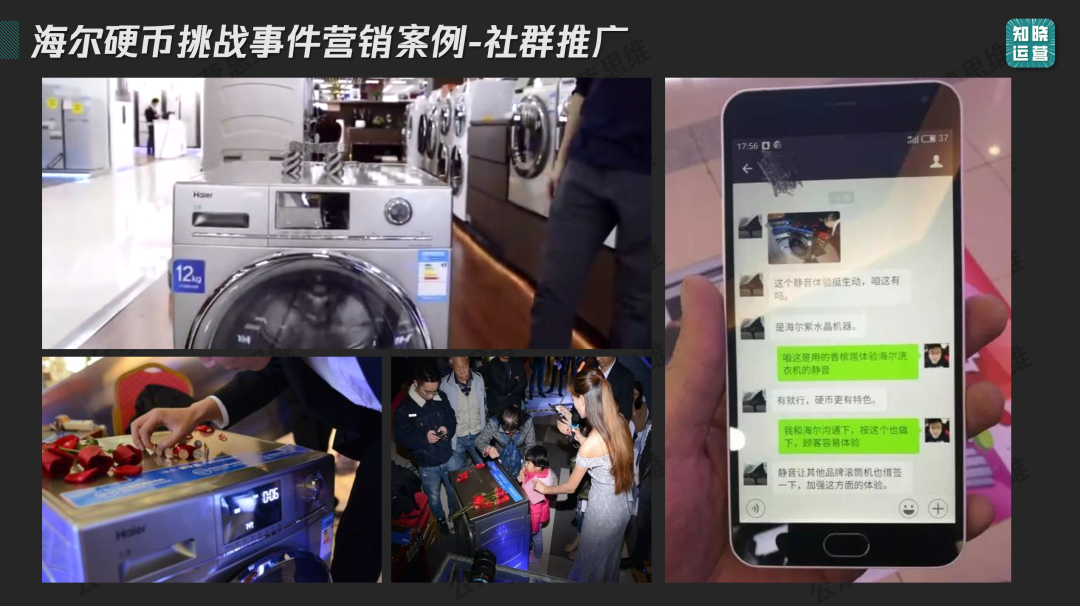
1) Awareness
Through the conflict scene of “the coin stands on the running washing machine and does not fall”, it creates content attention explosions. This content breaks the conventional model of traditional product promotion, arouses users’ curiosity and discussion through visually striking scenes, and quickly increases brand awareness.
2) Activation layer
Undertaking event marketing, the store’s private domain shares the event marketing videos highly disseminated on Weibo to users through the community, arousing user interest.
At the same time, the “Home Silence Challenge” was launched in the private domain community, where users can qualify for the test by uploading videos of their own washing machine noise, and through interactive content activities, potential users can be converted into active users and stimulate users’ sense of participation and enthusiasm.
3) Retention layer
The private domain regularly pushes the “Home Appliance Maintenance Guide”, and continues to provide valuable content on washing machine maintenance and functional use, which strengthens the brand memory of Haier washing machines for purchased users, and for wait-and-see users in the private domain, through interaction and dry content, the psychological balance of purchase is gradually tilted.
4) Referral
Set up a “silent ambassador” UGC reward mechanism, KOC users can earn membership points through private domain collection, public domain content release, share noise reduction before and after comparison videos, use the dissemination power of user-generated content (UGC) to promote new products, make full use of precipitated private domain user assets, and fission into public domain exposure and grass planting traffic.
01 A five-layer content system that penetrates the user’s mind
The first layer [contact layer]: WeChat private domain panoramic content construction
Private domain content is not a “one-pot stew”, but accurately matches the fragmented behavior of users through contact positioning, and then mobilizes psychological cues such as “interest”, “conversion” and “repurchase”.
Therefore, the content of WeChat’s private domain full scene, based on the unique differences in the “social” recommendation relationship, is actually worth iterating and layout, of course, we can choose the combination of content touchpoints according to our own advantageous content presentation methods, or iterate in stages.
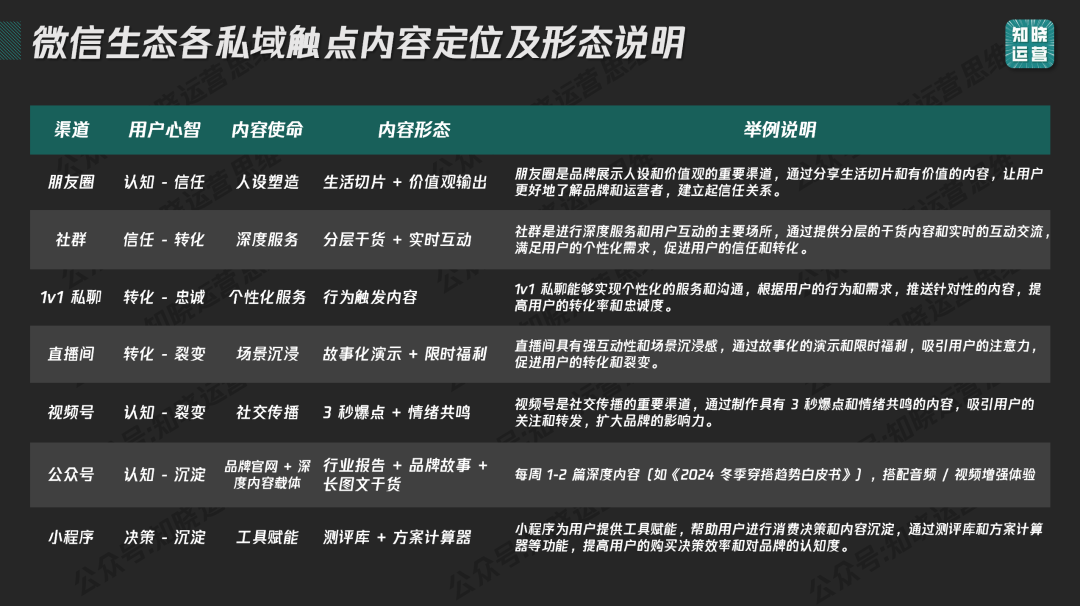
The effectiveness of private domain content does not lie in the explosive power of a single channel, but in the “chain chemistry” of global touchpoints, such as:
– Cognitive layer: Users “understand the brand” through popular content on the channels account, and “understand the brand” through in-depth articles on the official account;
– Trust layer: Observe the daily output of brand personas in the circle of friends, and participate in professional topic discussions in the community to discuss “like brands”;
– Conversion layer: “Decide to buy” through the scenario-based demonstration in the live broadcast room, complete the transaction in the mini program and precipitate as a member;
– Loyalty layer: Receive exclusive services through 1v1 private chats, share experiences in the community, and become a “loyal to the brand” of UGC communicators.
For example, let’s take one of the points here, taking the Douchai pet brand as an example
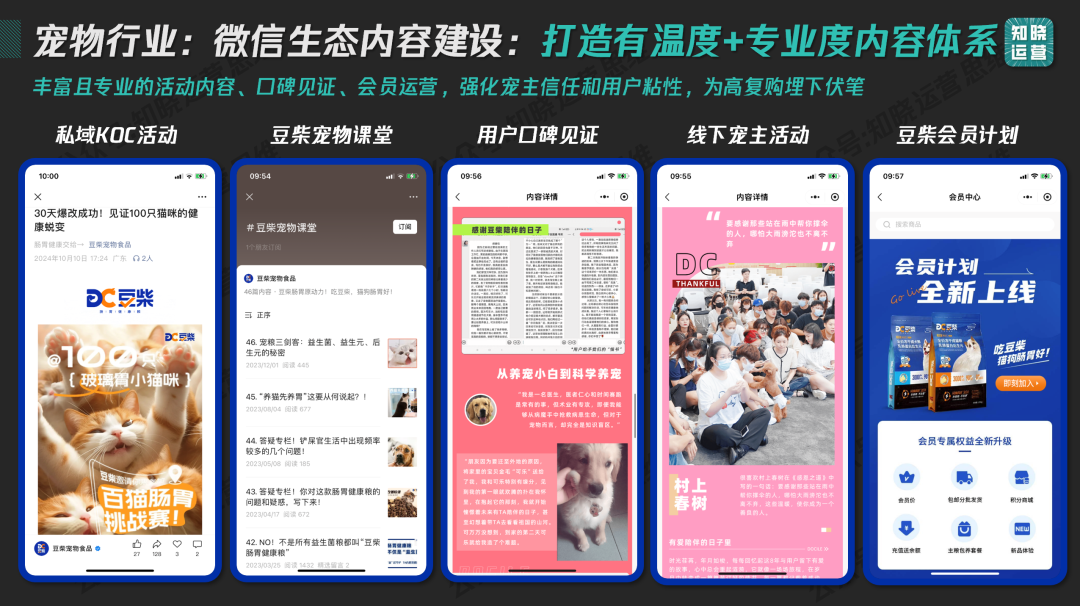
By holding activities such as the “100 Cats Gastrointestinal Challenge”, with the theme of “30 days of successful reform! Witness the healthy transformation of 100 cats” as a publicity point to attract the attention and participation of pet owners.
With the help of actual cases, we will show the positive effect of products on pet health, and use KOC to share activity experiences and results in the private domain, form word-of-mouth communication, attract more potential users, and enhance user stickiness and brand influence.
The essence of this progressive contact design is to focus on the user’s mental journey, use different forms of content to solve core problems at different stages, and finally form a complete closed loop of “traffic import→ trust construction→ value monetization→word-of-mouth fission”.
Brands need to avoid fragmentation of content across channels, but instead create a seamless content experience from the “user perspective”, so that every reach becomes an opportunity to deepen user relationships.
Layer 2 [User layer]: User lifecycle content hierarchy
The first step is to describe the corresponding content layering strategies under different life cycles:
Based on the above touchpoints, under the user life cycle, make content operation combinations for different touchpoints and different users.
According to Accenture’s research, brands that implement content layering strategies have an average increase of 2.8 times in user LTV. The key is to provide private domain “content customization meals” for users at different stages:
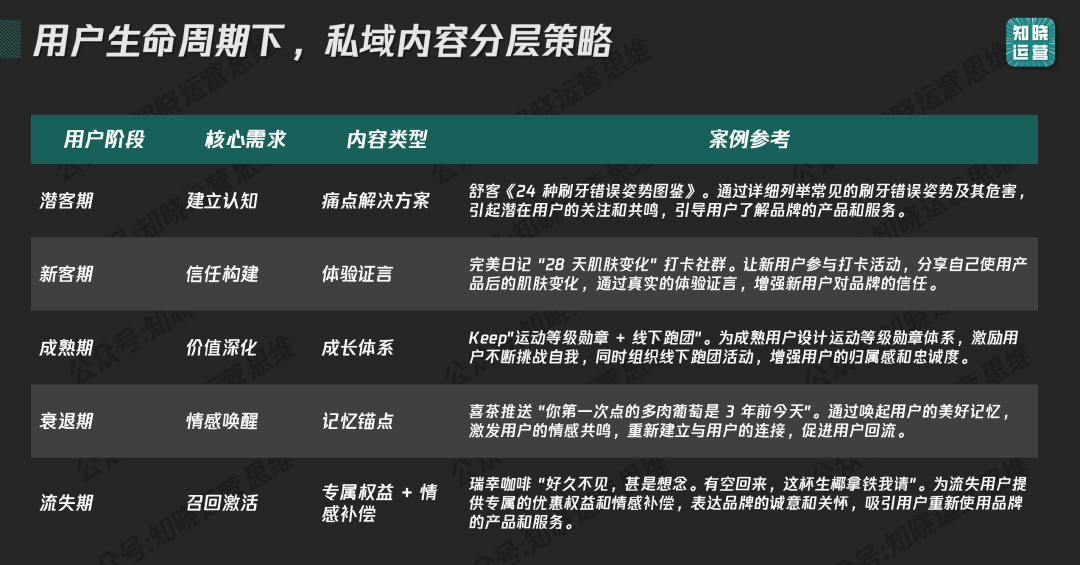
We divide the user life cycle into potential customers, new customers, maturity, decline, and churn.
For different businesses, under different cycles, sorting out different core needs, the potential customer period needs to establish cognition, the new customer period needs to build trust, the mature period pursues value deepening, the decline period needs emotional awakening, and the loss period aims to recall and activate.
According to the core needs of each stage, adaptive content is provided. Attract attention with pain point solutions during the potential customer period; The new customer period relies on physical testimony to enhance trust; the mature period motivates users with a growth system; during the recession period, the memory anchor is used to awaken emotions; The attrition period attracts return with exclusive rights and emotional compensation.
Step 2: According to different users, match the corresponding content for production
The hierarchical distribution and penetration of public domain to private domain content first construct different levels of private domain content matrix to penetrate users in layers, and then convey the overall value from three aspects of production, service and interaction through content productization.
Taking the education and training industry as an example, it is divided into two stages:
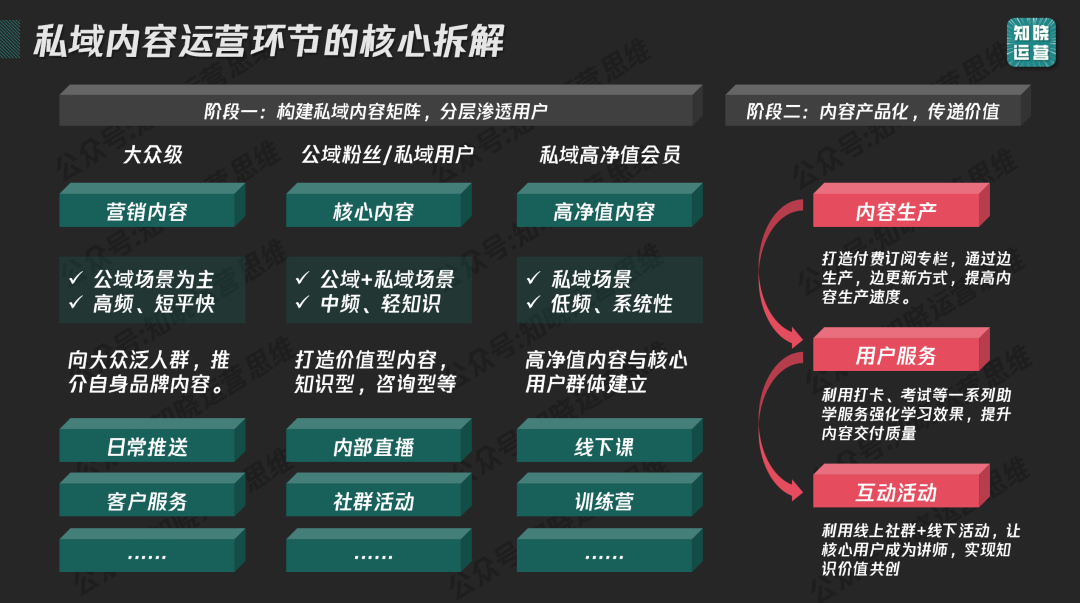
First, the construction of private domain content matrix and user hierarchical penetration
1) Marketing content:
It is mainly based on public domain scenes, characterized by high frequency, short and fast. The purpose is to introduce the company’s products and services to the widest user group and increase brand exposure, such as daily push and customer service.
2) Core content:
It covers both public and private domain scenarios, and is a medium frequency and light knowledge type. Create knowledge services around core content, deepen users’ awareness of the brand through strong interaction, live broadcasts and columns are common forms.
3) High net worth content:
Focus on private domain scenarios, showing low-frequency and systematic characteristics. With the help of such content, establish a solid connection with the core user group and enhance brand value, offline classes and training camps are representative forms.
Second, productize content and convey overall value
1) Content production: Create paid subscription columns, update them while producing, and improve the speed of content output.
2) User service: Use student assistance services such as check-in and exams to strengthen learning effects and improve the quality of content delivery.
3) Interactive experience: Through online communities and offline activities, core users can become lecturers and realize the co-creation of knowledge value.
Layer 3 [Content Layer]: “Scene Sense” is the upgrade of private domain content
1. The essence of the sense of scene: sense of substitution + emotional resonance
Users will not remember the product parameters, but will remember the “instant feeling of being moved in a certain scene”, and the content of the scene sense is the content of advanced empathy.
So what is a sense of scene?
“Sense of scene: “field” is the occasion, “scene” is the scene, and “feeling” is the feeling.
At its core, the sense of scene is to make the user feel that the content is “relevant to me” and trigger associations and emotions. We compare a set of private domain community or Moments copywriting, for example:
Poor case: “Our skin care products are naturally additive-free, come and buy them!” ”
Good scenario-based cases:
“I came home from overtime late at night and found that my cheeks were red and tingling when I removed my makeup. The next morning, you wet the water with mild plant extracts for 5 minutes, and the skin is finally no longer tight, and the morning of the original sensitive skin can also be calm. ”
2. Three core methods for constructing a sense of scene
1) Lock in the user’s real life scene
The core method is to refine high-frequency scenes (such as commuting, going to bed, bringing babies, dinner parties, etc.) from user portraits, and combine them with product function design content.
For example, take the scenario of maternal and infant products as an example:
“The baby cried in the middle of the night and refused to sleep, and you held him and paced back and forth in the living room, his wrists sore and shaking. At this time, the light baby carrier allows you to hold him with one hand, and the other hand can finally free up to make milk powder. ”
2) Enhance realism with “five sense details”
- Visual: describe the color and picture (e.g., “the sun shines through the curtain gap at 6 o’clock in the morning”);
- Auditory: add ambient sounds (such as “the coffee machine is buzzing, the milk foam is slowly expanding”);
- Tactile/somatosensory: emphasis on physical sensations (e.g., “cold wind drills into the collar, you wrap the wool scarf tightly”);
- Smell/taste: Associated memory points (e.g., “The aroma of freshly baked bread, that’s a memory of passing by after school when I was a child”).
3) Create a “conflict-resolution” storyline
This formula can be used to shape the content: pain point scene + emotional resonance + product solution
Take the content of the fitness scene as an example:
“Wearing the newly bought yoga pants, the waist and abdomen in the mirror are strangled out of fat (pain point scene). sighed and silently changed back to a loose T-shirt (emotion). It wasn’t until I practiced the ‘menstrual period-friendly yoga class’ that I realized that a little sweating can also quietly tighten the lines (solution). ”
The fourth layer [infrastructure layer]: build a content middle platform and build a private content brain
In the case of clothing brands at the beginning of the article, in the process of rebuilding the private domain content center, the question they raised was, “How to manage the private domain content touchpoints of dozens of stores and shopping guides every day, so that the whole link of production, distribution, and effect is visible?” ”
The private domain content center is an important part of supplementing this link, and its structure is divided into three layers:

1. Central kitchen: private domain content production mechanism
1) Material library
For example, the clothing category establishes a three-dimensional labeling system according to “product selling points (such as the windproof index of down jackets) – user pain points (such as winter commuting windproof needs) – scene keywords (such as ski resorts)” and stores 1000+ scenario-based materials.
In the future, for the launch of new clothing products, a material knowledge base will be built according to the content dimension, and a unified and detailed knowledge base will be provided for private domain content, product material map + product concept description + product scene map + dynamic video, the more detailed the private domain content details will be in place.
2) Formwork factory
Combined with fixed node content, develop standardized content templates such as “holiday marketing”, “new product launch” and “member care”, such as the “Christmas gift box” template, and polish the most effective SOP templates in the past, including 5 copywriting variations, 3 types of visual styles, and 2 sets of interactive mechanisms to sort out, and make changes and combinations when using them.
The development of standardized templates makes content production more standardized and efficient, reduces repetitive labor, and improves the consistency and professionalism of content.
3) AI-assisted production
Especially for copywriting content, by sorting out the copywriting structure suitable for the tone content of the company’s private domain, such as circle of friends, communities, and private chat skills, AI can learn and analyze the corresponding tone and content structure.
Then build customized prompts, build Feishu agents or use Feishu multi-dimensional tables, you can quickly produce private domain Moments, short video scripts, event speech content, etc., and improve the quality and efficiency of private domain content output.
2. Agile distribution: business processes that can be accurately reached
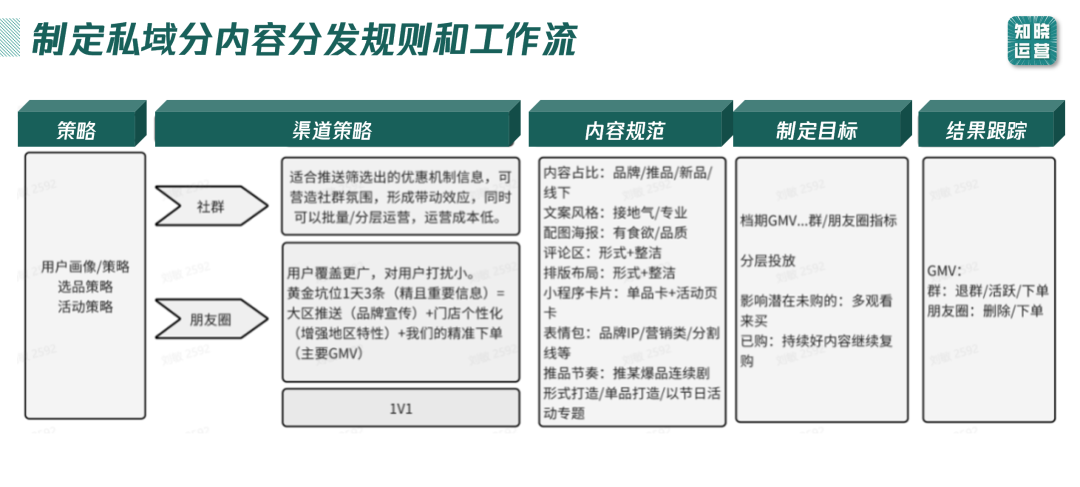
1) User tag matching
For example, based on private domain user data (such as browsing down jackets, unpaid additional purchases), the corresponding content is automatically pushed, such as “Cold Wave Warning: Are Your Windproof Gear Ready?”.
Through accurate user tag matching, personalized content push is realized, which improves the pertinence and effectiveness of content, and enhances user experience and conversion rate.
2) Channel strategy optimization
A/B testing determines the best time to publish, such as the Moments content of female users in the workplace is posted from 7:30 to 8:00 in the morning, and the open rate is 27% higher than the average.
Through continuous testing and optimization, the best publishing time for different channels and user groups is determined, improving the dissemination effect of content and user engagement.
3) Localization adaptation
The headquarters outputs general materials, and the regional team creates secondary creations according to the climate (such as Northeast China focuses on cold protection and South China focuses on moisture prevention) and regional culture (such as Chengdu stores adding hot pot scenes).
Localization adaptation brings the content closer to the actual needs and cultural backgrounds of users in different regions, improving the affinity and attractiveness of the content.
3. Data closed-loop: use effects to feed back content iteration
1) Rational data indicators
“Open rate, completion rate, engagement rate, conversion rate”
These basic indicators can intuitively reflect the communication effect and user engagement of the content, helping brands understand the strengths and weaknesses of the content.
But when it comes time to evaluate these content indicators, it is worth noting that for example, in our grass planting content, it is impossible to add conversion indicators to it, and we must first define content goals and then formulate key indicators.
2) Perceptual and emotional indicators
For many contents, there is actually no way to judge the quality of the content and whether it has achieved the goal through direct data.
In addition, emotional tendencies can also be analyzed to judge whether the content transmission and interaction process with private chats and group chats are positive or negative.
Level 5 [Organizational Layer]: From “Operations Department” to “Content-Based Organization”
No matter how good the middle office is, it needs people who can create content. The ultimate competition for private domain content is the competition of organizational capabilities.
1. Organizational structure: the importance of establishing private domain content
Taking the private domain operation organization system previously built for a clothing brand with an average customer order of 2,000 yuan+ as an example, the private domain content center department is independently pulled out as the operation center of the entire private domain system, and the full touch point is empowered.
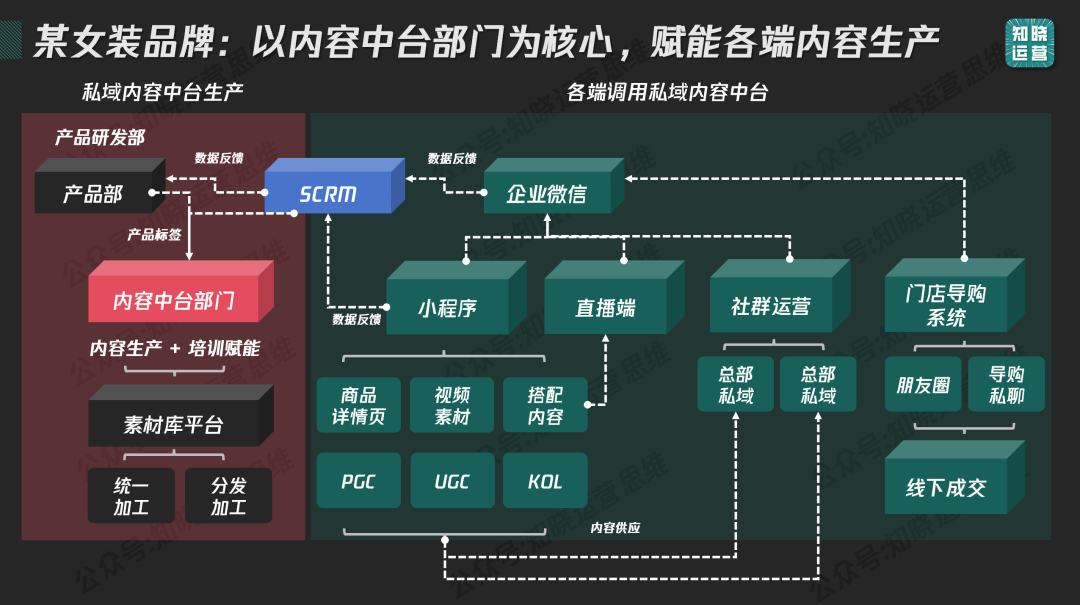
With the content center department (content department) as the core, it empowers the operation process of each department:
1) Content production and material management
-Content integration: Receive information from the product department with the product’s own label, as well as the label data connected by SCRM. Content production is carried out based on this. The produced content enters the material library, which can be processed and unified to meet the needs of the company’s content side.
-Material type: The materials in the material library include product detail pages, video materials, collocation content, etc., covering PGC, UGC, and KOL materials.
2) Content distribution and application
-Mini Program: The content of the material library is provided to the Mini Program, which carries various content forms such as product detail pages and video materials to display products and services, core content, etc. for users, and at the same time feeds back the generated data to SCRM and the content department to realize data return and optimize the content.
-Live broadcast side: Obtain content from the mini program, the live broadcast process enriches PGC materials, and the transaction scene of the live broadcast is associated with the enterprise WeChat to facilitate communication, and the live broadcast content can also help the community operate.
-Community Management: Enrich UGC materials with live content, and KOL materials can increase conversion rates. The community operation is communicated through enterprise WeChat, and the transaction scene is connected to the store shopping guide system.
-Store shopping guide system: receive community operation content, KOL, KOC materials to help improve the conversion rate, after offline transactions, customers can track individually, relevant content can also be shared to the circle of friends, and transaction scene information is fed back to enterprise WeChat.
3) Data feedback and loop
-SCRM: Collect data from each link and feedback to the product department and content department, the product department optimizes the product based on the feedback, and the content department optimizes the content production and distribution strategy based on the data, forming a closed-loop to continuously improve the operation effect. As a communication tool, Enterprise WeChat runs through all links to ensure the smooth transmission of information.
2. Job restructuring: set up three core roles
1) Private Domain Content Officer [Private Domain Content Manager Level]
Responsible for user research, content strategy formulation, and control of private domain content, you need to have both product thinking, content sensitivity and project management capabilities.
Based on user portrait analysis, according to the annual and quarterly, combined with the company’s main business and activities, the private domain content theme is formulated to ensure that the content resonates with product research and development and marketing activities at the same frequency.
For example, in the case of the dental cleaning category, in response to the pain points of “people who stay up late”, the content strategy officer takes the lead in researching private domain users and excavates or gains insight into user pain point scenarios, such as “awkward breath in the morning” is the core scenario.
Based on this, the “28-day oral renewal plan” private domain content interaction can be designed, covering morning check-in videos, night probiotic check-in communities, etc.
2) Content Executive [Private Domain Content Supervisor & Senior Commissioner Level]
Transform user needs into content solutions, such as designing content packages based on the “scenario-pain point-solution” model, and completing production with various departments.
Continuing with the example of dental cleaning,
The first step is to receive the survey data. Receive user survey data (such as community feedback “children resist brushing their teeth”) and break it down into a content combination of “parent-child interactive scenes + interesting brushing stories + cartoon toothbrush products”;
The second step is private domain content design. According to the company’s current children’s dental cleaning products, communicate with the product design department and deepen the product design concept, complete the shooting and collection of visual materials with the product shooting department, communicate with the marketing team, market activities and public domain promotion plans, and carry out multi-dimensional design of private domain content.
The third step is private domain content production. For example, the design team was coordinated to produce the short video content “The Wonderful Journey of Dentist Bear”, and the community activity of “brushing teeth and checking in to win toys” was simultaneously launched.
3. Capacity building: build a “content Whampoa Military Academy”
1) Internal training system
Monthly “scenario-based writing workshops” are held to train employees with the “pain point-five senses-story” model.
Improve the ability to capture the five senses through “blind test exercises”: show a picture of a “coffee shop on a rainy day” and ask employees to write scene copy containing vision (rain marks on glass), hearing (the sound of coffee machine steam), and smell (the aroma of caramel macchiato) within 5 minutes;
Through the “case dismantling meeting”, the head content is analyzed: for example, dismantling the private domain content chain of Heytea’s “Cool Blackberry Mulberry” (circle of friends “Black Mulberry Picking Record” + community “DIY Special Recipe Collection” + live broadcast room “Fruit Tea Making Challenge”), and refining the reusable “origin story + user co-creation + experience upgrade” model.
2) Performance appraisal
Include content quality indicators (such as interaction rate, UGC drive) into KPIs, accounting for no less than 30%, so that everyone pays attention to the quality of content production rather than quantity, and is not a single sales orientation.
For example, in terms of assessment dimension, it can be polished around these points:
– Content production efficiency: the number of original content per month, the reuse rate of material library;
– User participation: the average interaction time of a single piece of content, the emotional tendency of the comment area (proportion of positive comments);
– Business conversion: the proportion of GMV driven by content and the reach rate of high-value users (such as members).
-Incentive mechanism: Set up a “Content Innovation Award” to give fierce monthly bonuses to popular content creators to stimulate team innovation vitality.
Conclusion: The power of private domain content, the last kilometer of victory!
Building a private domain content system is by no means achieved overnight, it requires brands to be user-centered, and continue to cultivate in five dimensions: contact layout, life cycle stratification, scenario-based content, middle office infrastructure and organizational capabilities.
From avoiding pit traps to awakening the “oxygen theory”, from building a five-layer content system to making content the core kinetic energy of the organization, every step tests the brand’s insight into user needs and the execution of content innovation.
The future private domain competition is essentially a competition of content power. When brands truly integrate content into the bloodline of user operations, making every reach an accumulation of trust and every interaction an emotional connection, they can be invincible in the red sea of traffic.
After all, only by truly understanding the user’s content can we go through the cycle and make the private domain a perpetual motion machine for the long-term growth of the brand.




